
Culture • 03 April, 2025
Traditions of authentic Uzbek weddings
Uzbek wedding traditions go down deep into history. Just as ancestors honored traditions of hospitality and family values, modern generations strive to uphold these customs. A wedding has always been more than just the union of two hearts; it is a significant event for the entire family. Today, many ancient customs have been preserved, and enriched by modern elements. Colorful bright outfits, lavish feasts, and ancient rituals create an atmosphere of magic and mystery, which we will now explore further.
Engagement and preparation for the celebration
The preparations and associated rituals begin as early as the initial meeting of the prospective bride and groom. If the matchmaking is successful and the couple likes each other, the rite of "non sindirish" is held — the elders of both families break a flat bread in half as a symbol of the union of two families.
The main rite preceding the wedding is the "fatiha-tui", or engagement ceremony. This usually takes place a month before the wedding at the bride's home, where her parents are presented with the kalym — a symbolic “bride price” in a beautifully crafted wooden box. The groom’s senior relative hands over the kalym, along with the money the bride's family is presented with dozens of boxes containing halva, flatbreads with sesame seeds sprinkled on top, sweets, and fabrics.
On the eve of the wedding, a bridal shower/bachelorette party, "kizlar bazmi", is held at the bride’s home. Friends, sisters, and young neighbors gather to bid farewell to the bride’s single life, enjoying food and preparing the bride's makeup. In the old days, the "kizlar bazmi" included a now nearly extinct rite involving a weeper at the bridal shower. She would help the bride say goodbye to her youth and freedom, and it was believed that the louder and longer the bride wept, the easier and happier her married life would be. Wedding and the following days The wedding ("nikah-tui") lasts three days: on the first day, "maslahat oshi" takes place—a gathering of the elders of both families, where the details of the celebration are discussed over a meal of pilaf; on the second day, the wedding ceremony is held; and on the third day, "shukrona osh," a kind of thanksgiving dinner, is organized. In some regions of Uzbekistan, all events are held on specific days of the week: on Friday—the engagement, on Saturday—preparations for the wedding, and on Sunday—the nikah (wedding ceremony). A wedding during Nowruz holds special significance, as Nowruz itself marks the beginning of a new annual cycle, making it symbolic to congratulate the newlyweds on the start of their new life during this period. On the wedding day, the groom and his guests arrive at the bride's house closer to lunchtime. He is guided to the house along a symbolic white carpet called the "poyandoz". At the entrance, the groom faces a wall tent, part of which he must tear apart before entering. After this, the groom and his guests are treated to a meal of "kuyov oshi" (groom's pilaf).According to one regional tradition, the groom leaves a full handprint on the pilaf, and chocolate is placed where his fingers have left their mark, and the pilaf is then taken to the bride, thus wishing the young couple a sweet married life. During or after the meal, the bride's aunts and grandmothers bring a tray of gifts for the groom, known as "kuyov sarpo". This tray typically contains a chapan (traditional robe), a skullcap, and a waist scarf. One of the groom's close friends turns him toward Mecca and helps him put on the chapan (traditional robe). The empty tray is then passed around the groom’s friends, who place their gifts on it before returning it to the bride’s relatives. Depending on the region and adherence to traditions, customs that have survived since the time of Zoroastrianism were also practiced. For example, to ward off the evil eye, newlyweds were led around a fire several times, and later, when they needed to enter the house, a veil/cover was held over them. We asked Umida Akhmedova, the author of the film "Men and women: rites and ritual", about this fascinating tradition. – How do people perceive the traditions associated with Zoroastrianism, such as walking around the fire? How they are connected to our people? – People don’t consciously recognize and associate them with Zoroastrianism; it’s just how things have always been done. Elements of fire worship in Central Asia (and perhaps elsewhere—similar practices exist in the Caucasus and Iran) have been preserved not only in wedding ceremonies. In northern Uzbekistan, in Khorezm, lamps with fire are placed in niches at holy Muslim sites, and people clearly don’t think of Zoroastrianism. I’ve seen elements of fire worship among Catholics and Armenians too. On holidays, they jump over fires, and Russians burn effigies of winter. Azerbaijanis also jump over fires during Nowruz, showing that these fire-related rites have largely been preserved. However, lately, I’ve observed fire gradually disappearing from rites, as some people feel it doesn’t align with Islamic customs. There are also traditions in which the entire mahalla (neighborhood) participated: "korpa kavish"—the sewing and quilting of cotton blankets and kurpacha (mattresses) for the young couple; "sabzi tugrar"—the chopping of carrots for the wedding pilaf; and "mol yoyar"— displaying the bride's dowry to show it to all relatives and neighbors. – Toward the end of your film, there’s a scene where the bride and groom lie under a blanket, then a mirror is brought to them, and they are fumigated. What does this tradition signify, and how common is it? – Unfortunately, few places have preserved these magical rites. Many have been abolished under claims of inconsistency with Islamic traditions. This is a real challenge that hinders the study of history, ethnography, oral folk art, costumes, and so on. The tradition of showing the bride and groom their reflection goes far deeper into the past. Perhaps this is because in the past the bride and groom might not have seen each other before the wedding. Various games were created for the newlyweds who had never been close to one another. Some of these games were performed by women in a theatrical form. It is likely that all of this has some magical significance, the keys to which have been lost, but people continue to follow the traditions because it is customary. This scene was filmed almost 20 years ago in Khorezm, and the custom of presenting a mirror to the newlyweds and letting a child pass between them is now rarely practiced. We decided to ask local residents to learn more about wedding rituals in Khorezm: Bekposha Toirova:"I haven’t heard of the mirror tradition, but there is a rite where the bride and groom are placed under a blanket, and a child is allowed to pass between them. The child must be alone, between 1 and 5 years old — no older. The child must go under the blanket from the side of the newlyweds' feet and come out from the side of their heads. This is how they wish the couple to have many children". Kamila Ibragimova: "The first step in creating a new family unit is the "fatiha", or engagement ceremony. This signifies that both sides agree to the wedding. Housing is provided by the groom’s side, and shortly before the wedding, the bride’s side visits the home where the young couple will live to understand the layout of the rooms and their sizes. The bride’s side typically provides the dowry, which is known as "uy kurar". A few days before the wedding, several people, mainly women from the bride’s side, arrive at the groom's house to furnish the couple’s room with new furniture and prepare everything for the newlyweds. On the early morning of the wedding day, the bride's side treats everyone to pilaf. On average, around 300 people or more attend this event, and it is exclusively for men. When the groom arrives to pick up the bride, a table is set up for him and his friends, and pilaf must be served on the table. The groom feeds his unmarried friends and brothers as a gesture to encourage them to marry soon. In the evening, the wedding celebration takes place with guests, songs, and dances. There are also some unwritten traditions: before the event begins, elder women bless the groom, and young children are placed on his lap so that the couple may soon have children of their own. If a girl is placed, their first child is believed to be a girl; if a boy, the firstborn will be a boy. Then the groom goes to fetch the bride, who is sitting in the car waiting for her entrance. There is an interesting tradition associated with this moment: as the bride sets her foot on the ground, the groom must step on it at that moment. This signifies that the man is the head of the household". 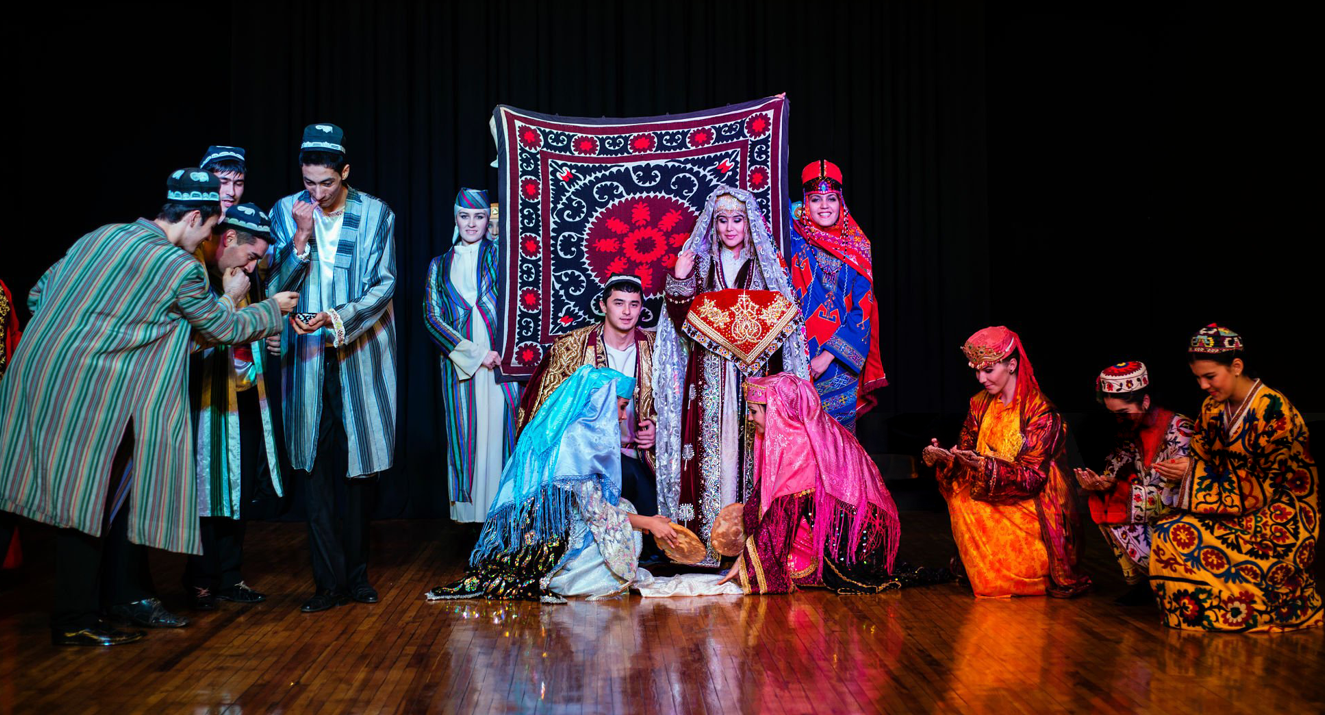
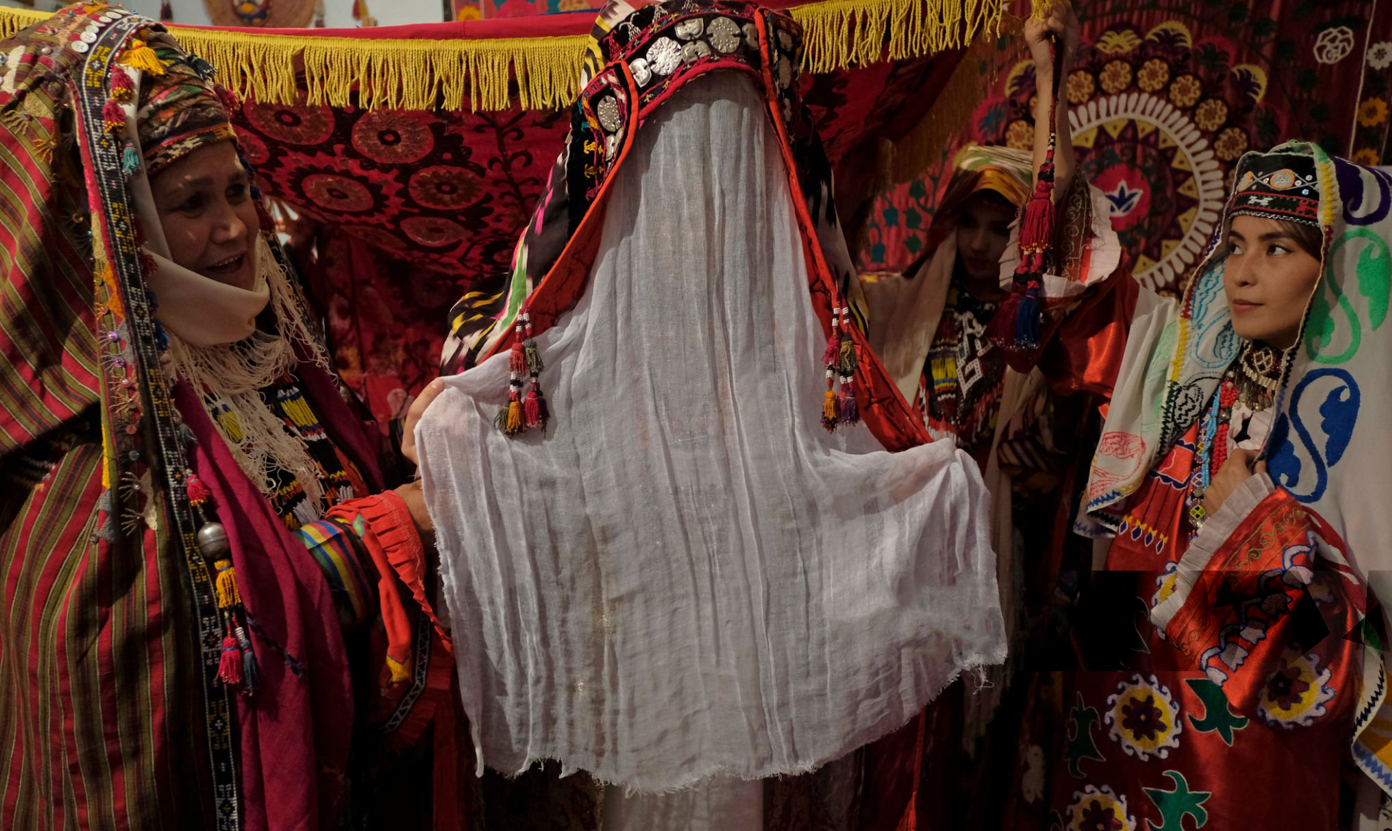
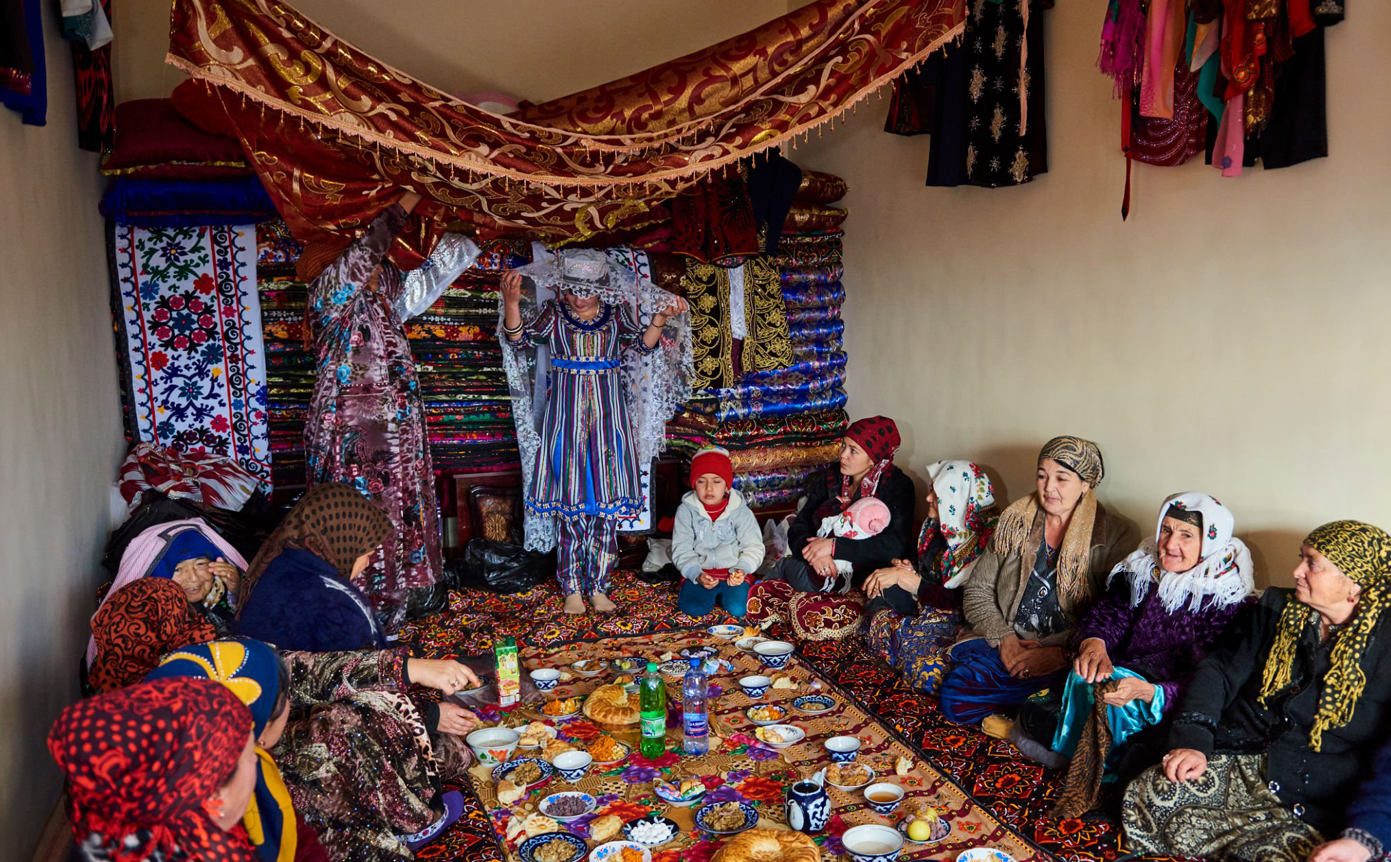
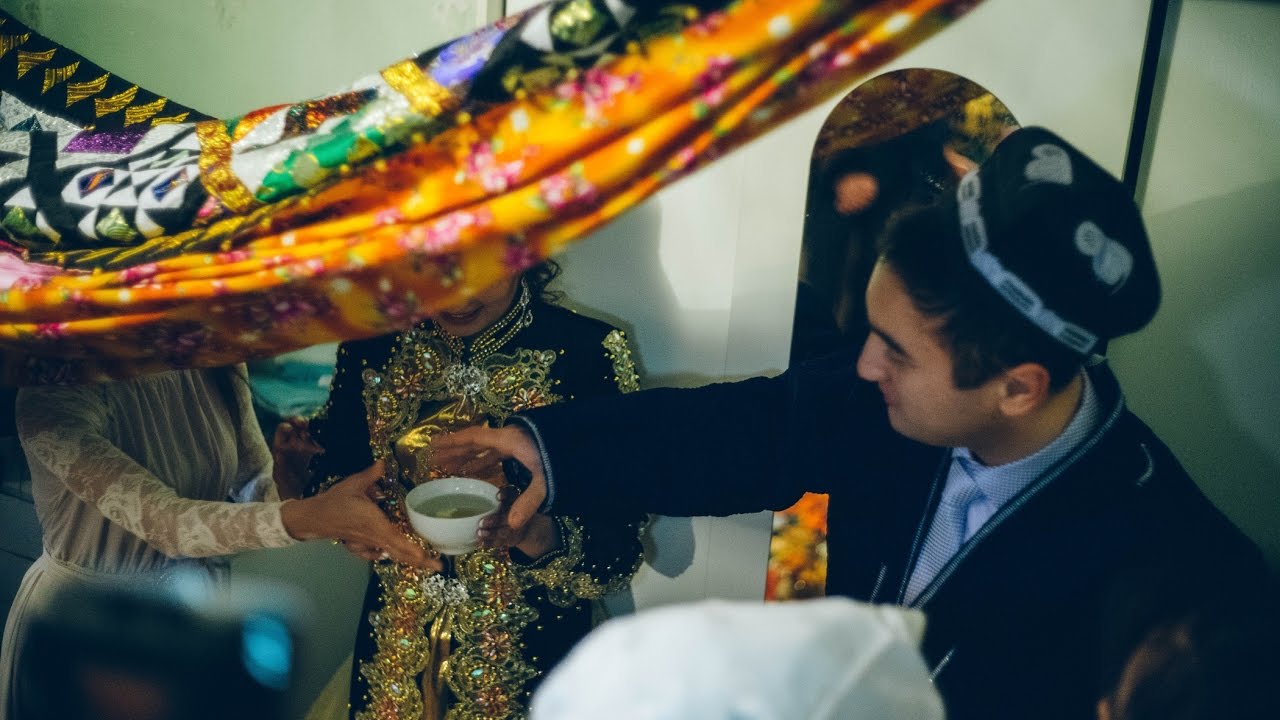
After the ceremony, the women sing the traditional wedding song "Yor-Yor", and everyone heads to the groom's house to celebrate the formation of the new family, known as the "toi bazm".
By the way, Umida Akhmedova calls "Yor-Yor" her favorite ceremonial song: "There is such a wedding song: a girl is escorted to her groom when she leaves her father's house. It has very touching music".
You can listen to it here: Uzbek folk (wedding) song — Yor-yor
In the groom’s house, a room is prepared for the bride – the "chivillik". It is an essential part of the room, with heavy curtains on all the windows decorated with beads and sequins/embroidery. The bride’s dowry and personal belongings are also placed there.
On the third day, the "kelin salom" ("the bride’s greetings") ceremony takes place — the greeting of the bride in her new home. An important part of this tradition is the flatbread, from which the bride must take the first bite, followed by her mother-in-law. This symbolizes a harmonious shared life and abundance in the household. After that, the mother-in-law gives the bride gold jewelry, and each relative on the groom’s side follows suit. Kelin (Editor's note: this is how the husband's relatives call the new bride who has joined their family), in turn, stands under a scarf and bows to each family member in gratitude.
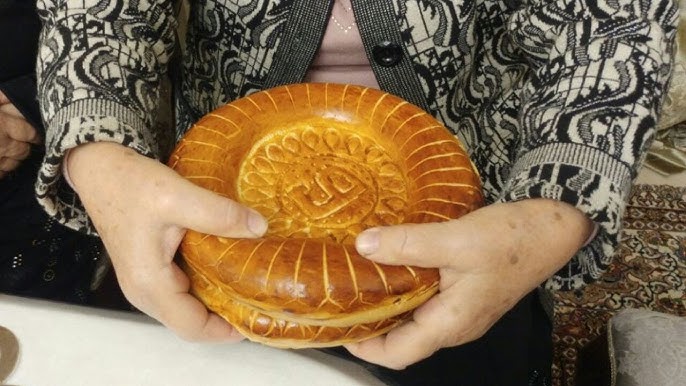
There are also traditions regarding the wedding attire for the couple. For the wedding ceremony, men wear a "kuylak" — a straight-cut shirt, "ishton" — wide trousers, and a "chapan" — a quilted robe with side slits, which is tied with a belt. The belt is often adorned or embroidered with silver, and the groom must wear a "tubeteika" (skullcap) on his head. The bride’s wedding outfit consists of a simple cut dress made of “khan-atlas” fabric and loose pants/bloomers. The headwear for women is a bit more complex and consists of three parts: a small hat, a scarf, and a turban.
These traditions, rituals, and ceremonies, some of which have been preserved in their original form to this day, make Uzbek weddings so unique. The harmonious blend of ancient customs and modern trends is a living testament to the rich history and culture of the people. It is not just a celebration but a journey into a world of traditions where the past harmoniously intertwines with the present.